There’s a new trend gradually appearing in Italian fine dining. It’s the rediscovery of the “classic” Italian culinary heritage, a sort of anthological heritage – an adjective we also used when writing about Niko Romito’s goals in his new restaurants, part of the Bulgari Hotel chain. It seems some of our best chefs – the most alert ones – have realised that after French grandeur, Spanish techniques and Nordic lessons, as well as the use of Asian spices and South American contrasts in flavours, it’s time to find a synthesis, at last. And one that has Italy as its place of origin. So they’ve understood that the Italian originality in contemporary fine dining – and its contribution – can only be found by reducing the rift that has appeared over the years between fine dining, with all the above mentioned influences and more, and the most typical and emblematic product of our cuisine: trattorias. That is to say, dishes presented by a host and strongly connected with the food that mothers and grandmothers have been making across the country.
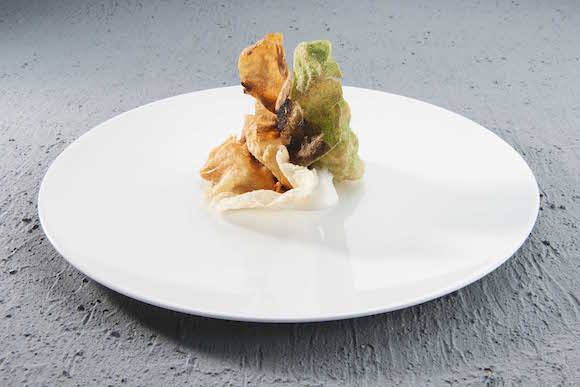
Massimo Bottura, The crispy part of lasagna (photo Brambilla-Serrani)
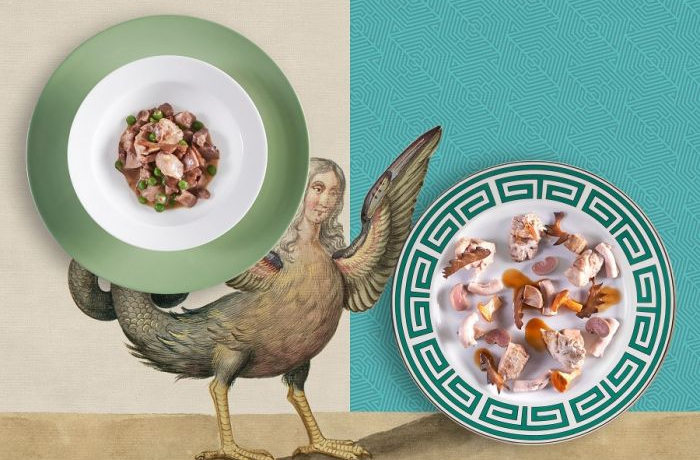
Matteo Baronetto, two versions of finanziera, the way it was, the way it is according to him, at Del Cambio in Torino
Take some masterpieces by
Massimo Bottura, who is a pioneer in re-elaborating Italian fine dining:
Compression of pasta and beans («We took the family recipe and revolutionised it») is from 2002,
The crispy part of lasagna from ten years later; behind them both is the idea that you can be current even when looking back, and giving new lymph to homemade or osteria-made cooking. We’ve already mentioned
Romito. But there’s also
Matteo Baronetto, for instance.
And now Luigi Taglienti, at his Lume in Milan is taking a further step: he’s saying that the new avant-garde lies in this very approach. So much so, he’s created a new tasting menu which he’s just presented.
«Today I know for sure that I want to stay in Italy, go nowhere else, so as to innovate my cuisine adding constant new energy, unearthing the ancient wisdom bestowed by mothers, grandmothers, farmers, fishermen. This thanks to a land and a knowledge that applied to products and ancient techniques today represent the most authentic possible innovation».
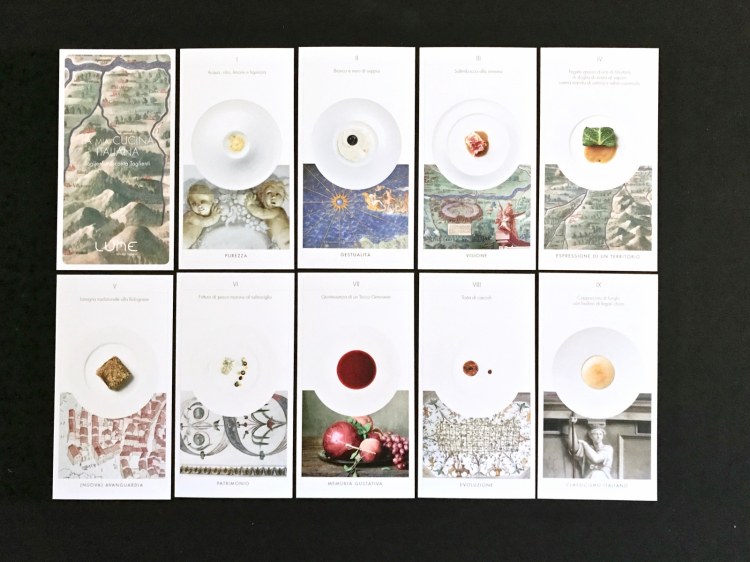
Taglienti and his cards, literally, in the game of new Italian cuisine
believes the cards Italy can and must play in order to represent the new culinary avant-garde must be searched in the chest of our past, or in the old recipe book of our late aunt, lost up in the attic. So it’s not about representing historic recipes, from
Apicio onwards (as in the case of
Riccardo Camanini, another Italian culinary and contemporary
maître à penser. See:
Camanini and the origins of Italian cuisine). It’s a different, equally ambitious challenge, that gives you goose pimples: a new take on
saltimbocca alla romana,
capunet,
frittura di pesce,
torta salata,
tocco genovese… Offering a current and convincing version.
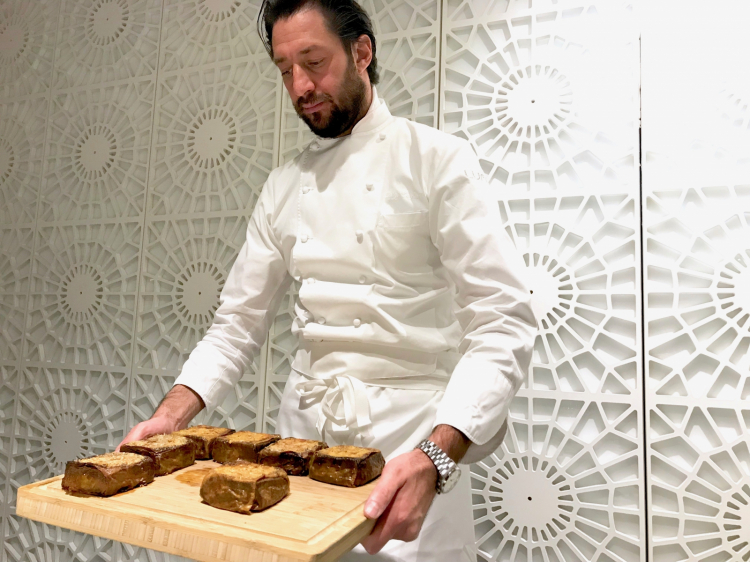
The chef serves his idea of Traditional Lasagne Bolognese
It’s a brave effort, because this new take of course has to face both the intrinsic culinary quality of the traditional version, and the culinary memories of each one of us. In other words: it’s difficult to match the lasagne made by someone’s mum. Not because they were good, but because they were made by
mum, marked in the emotional and cultural inheritance of each one of us. They’re almost iconic, that is.
«[My work is about] approaching new techniques by finding their origins in our history, broadening our view and getting back what belonged to us in the first place, our shared heritage, finally making space for the flavours typical of our palate and tradition, through the right process of evolution. I love retracing the features of what’s known, while respecting it, in an austere but essential way, simple yet never banal; unknown flavours that can evoke the past».
Taglienti is both shy and brave. He walks straight down his road, without paying attention to obstacles. So he decided to add this new menu, which we described above, to the two tasting menus already offered at
Lume (the creative and the classic one, dedicated to Milan). He first mentioned it at
Gastromasa, the fine dining congress that took place in Istanbul, Turkey, in December. We were there in the audience: «I’m taking back the heritage that was once passed down in families, and today we tend to forget. It has fallen into disuse – he said, while cooking an extraordinary
Quail – Italian style – So I’m returning to what’s typically Italian, like casserole tins. I’m taking back our past, the ancient techniques of my great-grandmother. I’m taking back
soffritto, vegetables sautéed with oil and a garlic clove, chopped capers, dry tomatoes, slow cooking», which are in fact the steps to take before roasting the above mentioned quail.
This said, Taglienti has now chosen lemon as his emblem. Because it’s basically the Italian timeless version of those contemporary acidities that are now so à la page, whether they’re based on Nordic fermentations, South American lime or Japanese yuzu. Lemons are local, and both modern and contemporary. The chef says: there are many flavours we risk loosing. The primordial aromas of Italian cuisine, which is now too influenced by the outside world, so much so its identity is diluted. We want to react by making them current.
«Through the use of acidity and lemon, which is now my emblem, I’ve recreated olfactory and emotional nuances while making tradition contemporary, adding alternating tactile and taste notes that add liveliness, speed, strength and freshness to my dishes. I’m discovering a new concept which I want to support in every way, on which I’ve been unknowingly working for some time, but is now finally clear to me. A shared language, the memory of the flavours of my region and of all of Italy, in terms of knowledge and memorable flavours. It’s not just about cooking: it’s a whole heritage that must be unearthed, knowing I have an ethical, cultural and social duty of illuminating what is now forgotten, and therefore stressing that cooking and gastronomy are part of culture, with their heritage of history, tradition, tradition, and their strong impact on society».
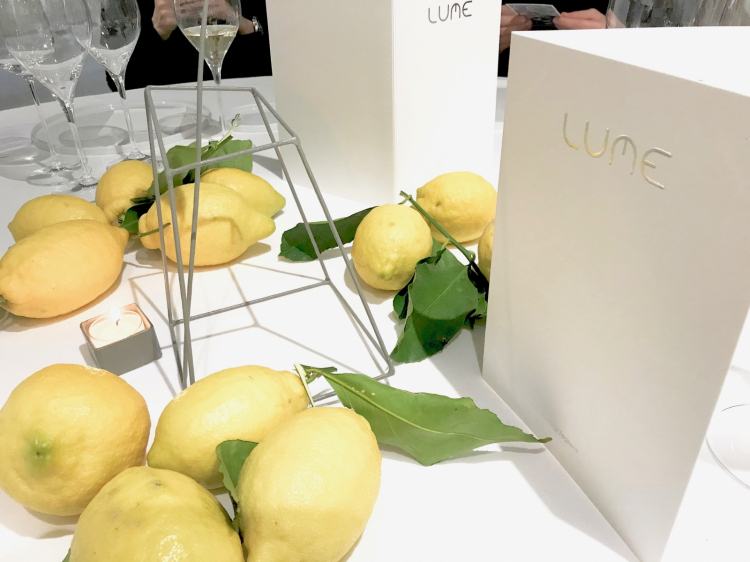
It’s a laborious task, as one can imagine, because it is based on undefined references, sometimes drawn from simple feelings: «Memories, scents, flavours. From north to south». With a constant reference to the
fil rouge of Italian cuisines: which in fact, rather than in our so variable dishes and product, can be found in that founding culinary institution that is called trattoria.
The outcome is in our photo gallery. It is sometimes undoubtedly fertile, and sometimes worth discussing. Indeed Taglienti has a tranchant style (as the word tagliente, cutting, suggests), that is to say rigorous, never keen on pleasing per se, never open to compromises. He doesn’t like a tie, he’s like the Zeman of cooking. He either wins or looses. You can love him or hate him: especially when speaking of the above-mentioned project.
Taglienti bets on himself, trying to trace an idea (or even just a practice) of New Italian Tradition.
Translated into English by Slawka G. Scarso